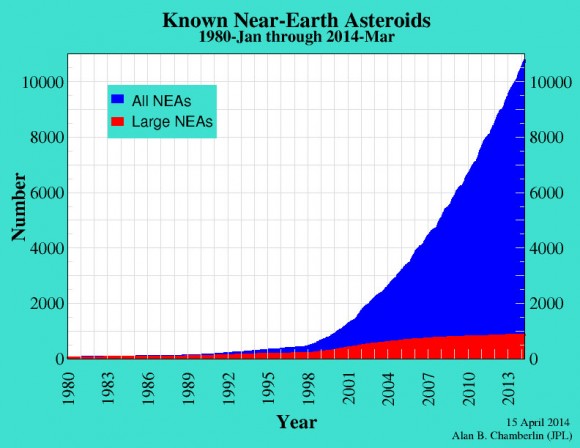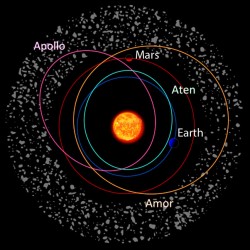 Diagram showing the orbit of 2014 KH39. Yellow shows the portion of its orbit above the plane of Earth’s orbit (grey disk); blue is below the plane. When farthest, the asteroid travels beyond Mars into the asteroid belt. It passes closest to Earth around 3 p.m. CDT June 3. Credit: IAU Minor Planet Center
Diagram showing the orbit of 2014 KH39. Yellow shows the portion of its orbit above the plane of Earth’s orbit (grey disk); blue is below the plane. When farthest, the asteroid travels beyond Mars into the asteroid belt. It passes closest to Earth around 3 p.m. CDT June 3. Credit: IAU Minor Planet Center
The chart shows the cumulative known total of near-Earth asteroids (NEAs) vs. time. The blue area shows all NEAs while the red shows those roughly 1 km and larger. Thanks to many ground-based surveys underway as well as space probes like the Wide-field Infrared Survey Explorer (WISE), discovery totals have ramped up in recent years. There are probably millions of NEOs smaller than 140 meters waiting to be discovered. Credit: NASA

Most near-Earth asteroids fall into three classes named after the first asteroid discovered in that class. Apollo and Aten asteroids cross Earth’s orbit; Amors orbit just beyond Earth but cross Mars’ orbit. Credit: Wikipedia
1 posted on
06/01/2014 2:48:56 PM PDT by
BenLurkin
To: BenLurkin
Bob King on So.. he's Klingon that can't type?
To: BenLurkin
Notice how the number of NEAs suddenly takes off about the time George W. Bush became President? For once something clearly is Bush's fault.
Not that Obama has fixed the problem...
To: BenLurkin
Notice how the number of NEAs suddenly takes off about the time George W. Bush became President? For once something clearly is Bush's fault.
Not that Obama has fixed the problem...
To: DJ MacWoW
5 posted on
06/01/2014 3:05:23 PM PDT by
Darksheare
(Try my coffee, first one's free..... Even robots will kill for it!)
To: BenLurkin
Makes me wonder, have we ever observed a large strike on the moon? It seems that given the history of the Earth, we should have observed a sizeable strike on the moon sometime in the last 2500 years.
14 posted on
06/01/2014 4:17:08 PM PDT by
SampleMan
(Feral Humans are the refuse of socialism.)
To: BenLurkin
too faint to spot in amateur telescopesOy! Settle on! Amateur telescopes can be even bigger than a massive 20 inch aperture. Amateur astronomers are no slouchers. For example: Variable Star Watch is largely due to the work of Amateur astronomers. The article probably meant to say that if you bought a small budget telescope at Walmart, you won't see the asteroid.
18 posted on
06/01/2014 4:42:49 PM PDT by
MrsEmmaPeel
(a government big enough to give you everything you want, is big enough to take everything you have)
FreeRepublic.com is powered by software copyright 2000-2008 John Robinson


